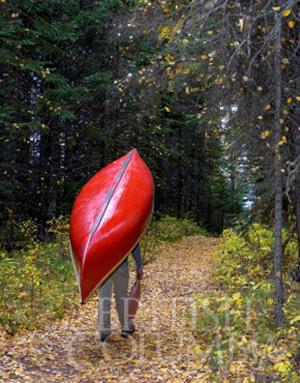
For his article “Sweet isolation” in the Spring 2013 issue of British Columbia Magazine, Contributing Editor Larry Pynn navigated the unspoiled wilderness of Nenikëkh/Nanika-Kidprice Provincial Park by canoe. The trip was rewarding, says Pynn, but required some tough portaging. Here, the expert outdoorsman provides a few tips on how to properly portage.
- Before beginning the portage, make sure oversized loose gear, such as paddles and fishing rods, is secured with bungee chords. Keep your other gear in your backpack and pack light. Consider carrying your pack down the portage trail before the canoe to learn the route and clear any deadfall.
- Position one person at the bow (where the weight is lightest) and one at the stern. The lead person should put the tip of the bow on his/her shoulders for a clear view of the route ahead.
- For short portages over steep or rough terrain, carry the canoe low, open side up, with one person each at the bow and stern. That way, the canoe won’t drop unexpectedly, you won’t lose your footing, and you can easily put it down to take a rest.
- Solo portages involve less coordination; one person can carry the canoe the entire distance alone, while the other person hauls the packs. For proper balance, hoist the canoe onto your shoulders at the yoke in the middle of the canoe. Used correctly, a tumpline strap around your head may also help by shifting weight from the shoulders to the spine. Note: unless you are experienced at lifting the canoe alone, it’s best to enlist your paddling partner.
- The trip-and-a-half method involves one person carrying the canoe and the other person a pack. Halfway through the portage, the person carrying the canoe stops and returns for the second pack, while the other person continues to the end, then returns for the canoe.
Good to know:
Well-maintained canoe destinations, such as Bowron Lake Provincial Park and Murtle Lake in Wells Gray Provincial Park, allow canoes to be portaged on carts, which is heaven by comparison. Carts typically cost about $100 and up and can pay for themselves after only a few uses.

